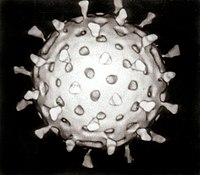
Photo from wikipedia
INTRODUCTION Livestock diseases are a major constraint to agricultural productivity, frequently causing significant livelihood losses for farmers, and negatively affecting public food safety and security. Vaccines provide an effective and… Click to show full abstract
INTRODUCTION Livestock diseases are a major constraint to agricultural productivity, frequently causing significant livelihood losses for farmers, and negatively affecting public food safety and security. Vaccines provide an effective and profitable means for controlling most infectious livestock diseases, but remain underutilized. This study sought to assess the barriers and determinants of vaccination utilization for priority livestock diseases in Ghana. METHODS We conducted a mixed-method study involving a quantitative survey with ruminant livestock farmers (N = 350) and seven focus group discussions (FGD) involving 65 ruminant livestock farmers. The survey data were analyzed, and distribution of barriers to vaccination access described. We evaluated the determinants of vaccination utilization (any use of vaccination against contagious-bovine-pleuropneumonia (CBPP) and peste-des-petits-ruminants (PPR) in 2021) using logistic regression analyses at the 0.05 significance level. FGD transcripts were analyzed deductively. We used triangulation to achieve convergence across the different datasets and analyses. RESULTS The farmers kept an average (median) of 5 tropical livestock units (TLUs) of ruminant livestock (IQR=2.6-12.0) that were on average 8 kilometers (IQR=1.9-12.4) away from veterinary officers (VOs). Only 16% (56/350) of herds were vaccinated against the diseases. Most farmers (274/350) had limited knowledge on vaccines against CBPP and PPR infections, 63% (222/350) perceived low risk of these diseases to their herds. About half of farmers reported experiencing outbreaks of either disease in the study year (2021). Farmers scored on average 80.5 out of 98 (IQR=74-85) on the RS-14 resilience scale. After adjusting for farmers' livestock rearing experience, herd size, sex, wealth status, distance to VOs, previous disease outbreaks, and perceived risk of the diseases, vaccination utilization was negatively associated with limited knowledge (aOR=0.19, 95%CI=0.08-0.43), and positively associated with personal exposure to outbreaks in the study year (aOR=5.26, 95%CI=2.01-13.7) and increasing resilience (aOR=1.13, 95%CI=1.07-1.19). FGDs revealed farmer misconceptions about vaccines, costs of vaccines, and timely access to vaccines from VOs as additional barriers. CONCLUSIONS Acceptability, affordability, accessibility, and availability of vaccine services represent the main barriers to vaccines utilization by ruminant livestock farmers in Ghana. Given that limited knowledge regarding the value of vaccination and shortfalls in veterinary service supply are of central importance for both the demand and supply side, more collaboration between the different stakeholders in a transdisciplinary manner to effectively address the low vaccination utilization problem is needed.
Journal Title: Preventive veterinary medicine
Year Published: 2023
Link to full text (if available)
Share on Social Media: Sign Up to like & get
recommendations!